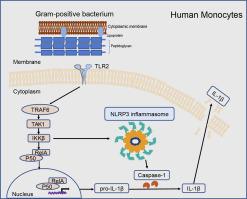Cytokine ( IF 3.7 ) Pub Date : 2023-07-20 , DOI: 10.1016/j.cyto.2023.156302 Mengdan Chen 1 , Shi Yu 1 , Yuhui Gao 2 , Jiaxun Li 1 , Xun Wang 3 , Bin Wei 4 , Guangxun Meng 5

|
Gram-positive bacterial infection causes high morbidity and mortality worldwide, while the underlying mechanism for host sensing bacterial components and initiating immune responses remains elusive. The NLRP3 inflammasome is a cytosolic multi-protein complex sensing a broad spectrum of endogenous danger signals and environmental irritants. In contrast to canonical NLRP3 inflammasome activation that needs both priming and activation signals, Lipopolysaccharide (LPS) from gram-negative bacteria activates the “one-step” NLRP3 inflammasome in human monocytes, which relies on the TLR4-TRIF-Caspase-8 signaling. Here, we show that in human monocytes, TLR2 agonists such as heat-killed gram-positive bacteria, peptidoglycan (PGN) or synthetic bacterial lipoprotein analog Pam3CysSerLys4 (Pam3CSK4) are able to induce the “one-step” NLRP3 inflammasome activation. Using genetic targeting and pharmacological inhibition approaches, it was found that TLR2 propagates signal through TRAF6, TAK1 and IKKβ, ultimately activated NLRP3 independent of RelA. In addition, IKKβ interacts with NLRP3 directly and affects NLRP3 inflammasome activation. These results reveal the signaling cascade downstream of TLR2 upon sensing gram-positive bacterial infection and activating the “one-step” NLRP3 inflammasome in human monocytes, which provides clue for controlling gram-positive bacterial infection-related inflammation.
中文翻译:

TRAF6-TAK1-IKKβ 通路介导 TLR2 激动剂“一步”激活人单核细胞中的 NLRP3 炎症小体
革兰氏阳性细菌感染在世界范围内导致高发病率和死亡率,而宿主感知细菌成分和启动免疫反应的潜在机制仍然难以捉摸。NLRP3 炎症小体是一种胞质多蛋白复合物,可感知广泛的内源性危险信号和环境刺激物。与需要启动信号和激活信号的典型 NLRP3 炎症小体激活相反,来自革兰氏阴性细菌的脂多糖 (LPS) 可激活人类单核细胞中的“一步式”NLRP3 炎症小体,该过程依赖于 TLR4-TRIF-Caspase-8 信号传导。在这里,我们表明,在人类单核细胞中,TLR2激动剂,例如热灭活的革兰氏阳性菌、肽聚糖(PGN)或合成细菌脂蛋白类似物Pam3CysSerLys4(Pam3CSK4)能够诱导“一步式”NLRP3炎性体激活。利用基因靶向和药理学抑制方法,发现TLR2通过TRAF6、TAK1和IKKβ传播信号,最终独立于RelA激活NLRP3。此外,IKKβ直接与NLRP3相互作用并影响NLRP3炎症小体的激活。这些结果揭示了TLR2下游在感知革兰氏阳性细菌感染并激活人单核细胞中“一步式”NLRP3炎症小体时的信号级联反应,这为控制革兰氏阳性细菌感染相关炎症提供了线索。













































 京公网安备 11010802027423号
京公网安备 11010802027423号